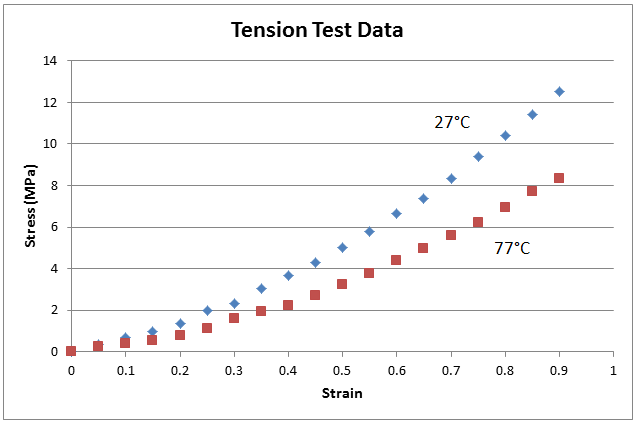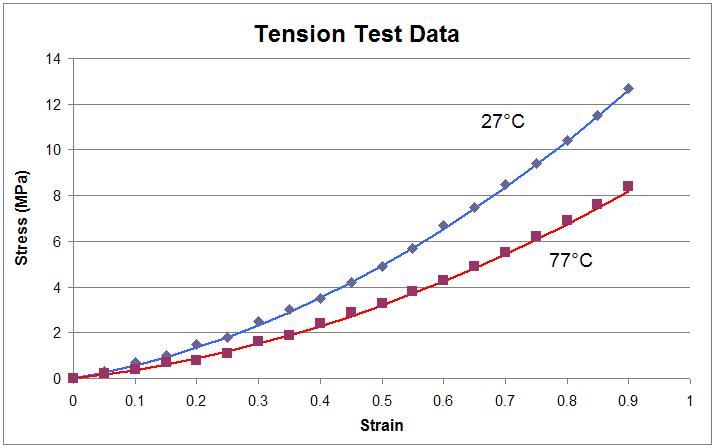\[ \rho \, \left( {\partial {\bf v} \over \partial t} + {\bf v} \cdot \nabla {\bf v} \right) = -\nabla P + 2 \mu \nabla \cdot {\bf D}' + \rho {\bf f} \]
and use tensor notation to show how to get to the equation below, which occurs farther down the page.
\[ \rho \, \left( v_{i,t} + v_k v_{i,k} \right) = -P,_x + 2 \, \mu \, D'_{ij,j} + \rho f_i \]
Substitute \(D_{ij,j} - {1 \over 3} \delta_{ij} D_{kk,j}\) for \(D'_{ij,j}\).
\[ \rho \, \left( v_{i,t} + v_k v_{i,k} \right) = -P,_x + 2 \, \mu \, \left( D_{ij,j} - {1 \over 3} \delta_{ij} D_{kk,j} \right) + \rho f_i \]
Expand out and swap out \(\delta_{ij}\).
\[ \rho \, \left( v_{i,t} + v_k v_{i,k} \right) = -P,_x + 2 \, \mu \, D_{ij,j} - {2 \over 3} \mu \, D_{kk,i} + \rho f_i \]
Replace \(D_{ij}\) with \({1 \over 2} (v_{i,j} + v_{j,i})\), and replace \(D_{kk}\) with \(v_{k,k}\).
\[ \rho \, \left( v_{i,t} + v_k v_{i,k} \right) = -P,_x + \mu \, (v_{i,jj} + v_{j,ij}) - {2 \over 3} \mu \, v_{k,ki} + \rho f_i \]
But \(v_{j,ij}\) and \(v_{k,ki}\) are the same thing, so combine to get
\[ \rho \, \left( v_{i,t} + v_k v_{i,k} \right) = -P,_x + \mu \, v_{i,jj} + {1 \over 3} \mu \, v_{j,ji} + \rho f_i \]
But \(v_{j,ji}\) is the same thing as \((v_{j,j}),_i\) and for incompressible materials, \(v_{j,j}\) is zero. So this term drops out to give
\[ \rho \, \left( v_{i,t} + v_k v_{i,k} \right) = -P,_x + \mu \, v_{i,jj} + \rho f_i \]
which can be written in matrix notation as
\[ \rho \, \left( {\partial {\bf v} \over \partial t} + {\bf v} \cdot \nabla {\bf v} \right) = -\nabla P + \mu \nabla^2 {\bf v} + \rho \, {\bf f} \]

| 27°C | 77°C | |
|---|---|---|
| Strain | Stress (MPa) | Stress (MPa) |
| 0 | 0 | 0 |
| 0.05 | 0.3 | 0.2 |
| 0.10 | 0.7 | 0.4 |
| 0.15 | 1.0 | 0.7 |
| 0.20 | 1.5 | 0.8 |
| 0.25 | 1.8 | 1.1 |
| 0.30 | 2.5 | 1.6 |
| 0.35 | 3.0 | 1.9 |
| 0.40 | 3.5 | 2.4 |
| 0.45 | 4.2 | 2.9 |
| 0.50 | 4.9 | 3.3 |
| 0.55 | 5.7 | 3.8 |
| 0.60 | 6.7 | 4.3 |
| 0.65 | 7.5 | 4.9 |
| 0.70 | 8.5 | 5.5 |
| 0.75 | 9.4 | 6.2 |
| 0.80 | 10.4 | 6.9 |
| 0.85 | 11.5 | 7.6 |
| 0.90 | 12.7 | 8.4 |
Propose the following function for the Helmholtz free energy.
\[ \Psi = { \text{20E6} \, \epsilon^2 + \text{30E6} \, \epsilon^3 \over T^{2.8} } \]
Keep in mind that temperature must be in Kelvin, use 300K and 350K.
Take the derivative to get
\[ \sigma = {\partial \Psi \over \partial \epsilon} = { \text{40E6} \, \epsilon + \text{90E6} \, \epsilon^2 \over T^{2.8} } \]
Plot this on the graph.
